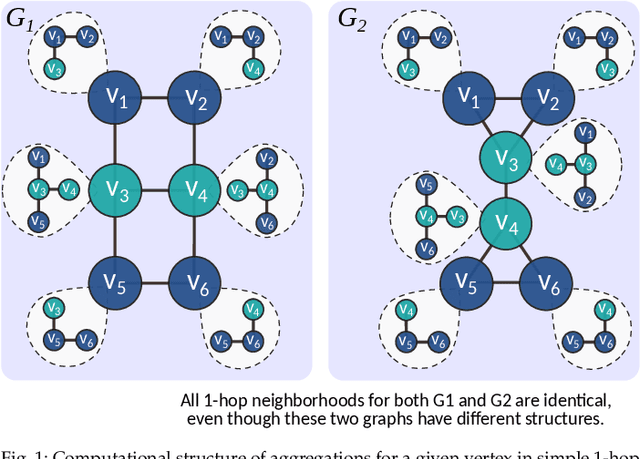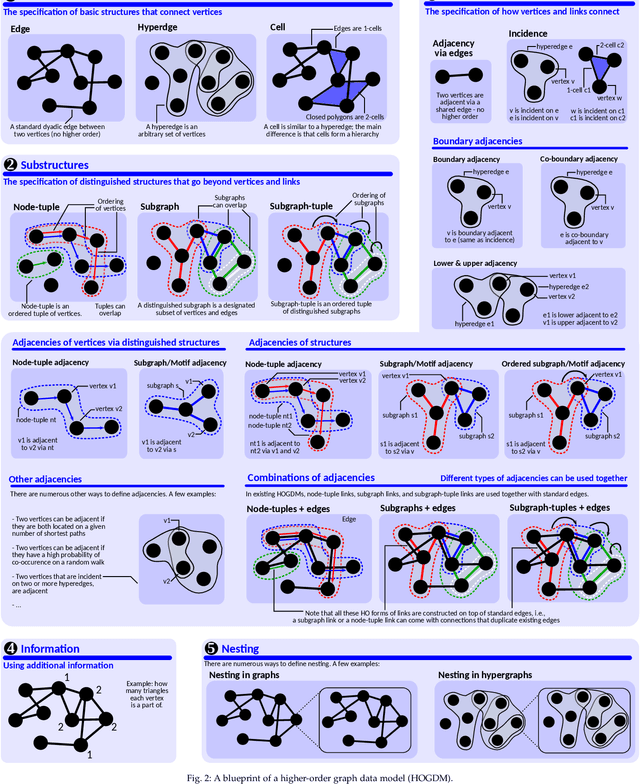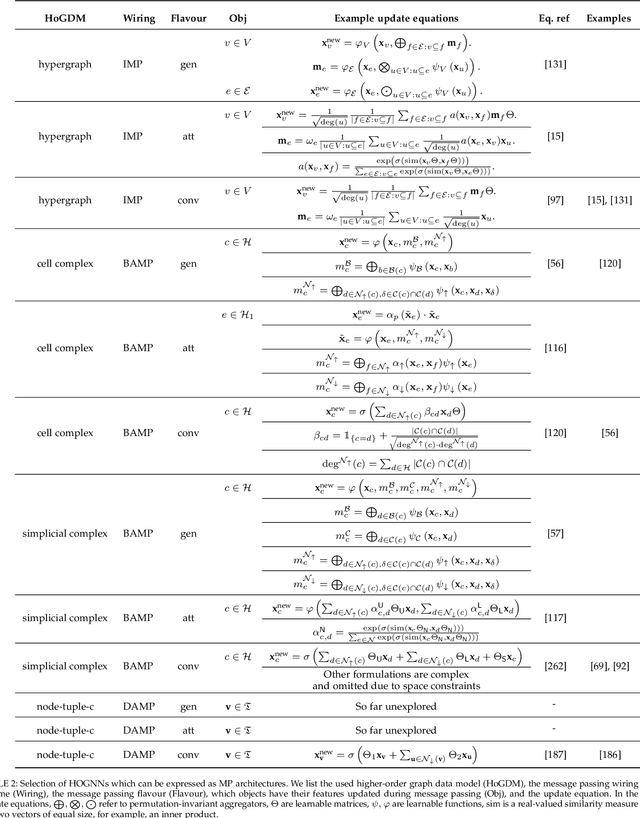Jürgen Müller
Higher-Order Graph Databases
Jun 24, 2025Abstract:Recent advances in graph databases (GDBs) have been driving interest in large-scale analytics, yet current systems fail to support higher-order (HO) interactions beyond first-order (one-hop) relations, which are crucial for tasks such as subgraph counting, polyadic modeling, and HO graph learning. We address this by introducing a new class of systems, higher-order graph databases (HO-GDBs) that use lifting and lowering paradigms to seamlessly extend traditional GDBs with HO. We provide a theoretical analysis of OLTP and OLAP queries, ensuring correctness, scalability, and ACID compliance. We implement a lightweight, modular, and parallelizable HO-GDB prototype that offers native support for hypergraphs, node-tuples, subgraphs, and other HO structures under a unified API. The prototype scales to large HO OLTP & OLAP workloads and shows how HO improves analytical tasks, for example enhancing accuracy of graph neural networks within a GDB by 44%. Our work ensures low latency and high query throughput, and generalizes both ACID-compliant and eventually consistent systems.
Reasoning Language Models: A Blueprint
Jan 20, 2025Abstract:Reasoning language models (RLMs), also known as Large Reasoning Models (LRMs), such as OpenAI's o1 and o3, DeepSeek-V3, and Alibaba's QwQ, have redefined AI's problem-solving capabilities by extending large language models (LLMs) with advanced reasoning mechanisms. Yet, their high costs, proprietary nature, and complex architectures - uniquely combining Reinforcement Learning (RL), search heuristics, and LLMs - present accessibility and scalability challenges. To address these, we propose a comprehensive blueprint that organizes RLM components into a modular framework, based on a survey and analysis of all RLM works. This blueprint incorporates diverse reasoning structures (chains, trees, graphs, and nested forms), reasoning strategies (e.g., Monte Carlo Tree Search, Beam Search), RL concepts (policy, value models and others), and supervision schemes (Output-Based and Process-Based Supervision). We also provide detailed mathematical formulations and algorithmic specifications to simplify RLM implementation. By showing how schemes like LLaMA-Berry, QwQ, Journey Learning, and Graph of Thoughts fit as special cases, we demonstrate the blueprint's versatility and unifying potential. To illustrate its utility, we introduce x1, a modular implementation for rapid RLM prototyping and experimentation. Using x1 and a literature review, we provide key insights, such as multi-phase training for policy and value models, and the importance of familiar training distributions. Finally, we outline how RLMs can integrate with a broader LLM ecosystem, including tools and databases. Our work demystifies RLM construction, democratizes advanced reasoning capabilities, and fosters innovation, aiming to mitigate the gap between "rich AI" and "poor AI" by lowering barriers to RLM development and experimentation.
Demystifying Higher-Order Graph Neural Networks
Jun 18, 2024



Abstract:Higher-order graph neural networks (HOGNNs) are an important class of GNN models that harness polyadic relations between vertices beyond plain edges. They have been used to eliminate issues such as over-smoothing or over-squashing, to significantly enhance the accuracy of GNN predictions, to improve the expressiveness of GNN architectures, and for numerous other goals. A plethora of HOGNN models have been introduced, and they come with diverse neural architectures, and even with different notions of what the "higher-order" means. This richness makes it very challenging to appropriately analyze and compare HOGNN models, and to decide in what scenario to use specific ones. To alleviate this, we first design an in-depth taxonomy and a blueprint for HOGNNs. This facilitates designing models that maximize performance. Then, we use our taxonomy to analyze and compare the available HOGNN models. The outcomes of our analysis are synthesized in a set of insights that help to select the most beneficial GNN model in a given scenario, and a comprehensive list of challenges and opportunities for further research into more powerful HOGNNs.
Multi-Head RAG: Solving Multi-Aspect Problems with LLMs
Jun 07, 2024Abstract:Retrieval Augmented Generation (RAG) enhances the abilities of Large Language Models (LLMs) by enabling the retrieval of documents into the LLM context to provide more accurate and relevant responses. Existing RAG solutions do not focus on queries that may require fetching multiple documents with substantially different contents. Such queries occur frequently, but are challenging because the embeddings of these documents may be distant in the embedding space, making it hard to retrieve them all. This paper introduces Multi-Head RAG (MRAG), a novel scheme designed to address this gap with a simple yet powerful idea: leveraging activations of Transformer's multi-head attention layer, instead of the decoder layer, as keys for fetching multi-aspect documents. The driving motivation is that different attention heads can learn to capture different data aspects. Harnessing the corresponding activations results in embeddings that represent various facets of data items and queries, improving the retrieval accuracy for complex queries. We provide an evaluation methodology and metrics, synthetic datasets, and real-world use cases to demonstrate MRAG's effectiveness, showing improvements of up to 20% in relevance over standard RAG baselines. MRAG can be seamlessly integrated with existing RAG frameworks and benchmarking tools like RAGAS as well as different classes of data stores.
Topologies of Reasoning: Demystifying Chains, Trees, and Graphs of Thoughts
Jan 25, 2024Abstract:The field of natural language processing (NLP) has witnessed significant progress in recent years, with a notable focus on improving large language models' (LLM) performance through innovative prompting techniques. Among these, prompt engineering coupled with structures has emerged as a promising paradigm, with designs such as Chain-of-Thought, Tree of Thoughts, or Graph of Thoughts, in which the overall LLM reasoning is guided by a structure such as a graph. As illustrated with numerous examples, this paradigm significantly enhances the LLM's capability to solve numerous tasks, ranging from logical or mathematical reasoning to planning or creative writing. To facilitate the understanding of this growing field and pave the way for future developments, we devise a general blueprint for effective and efficient LLM reasoning schemes. For this, we conduct an in-depth analysis of the prompt execution pipeline, clarifying and clearly defining different concepts. We then build the first taxonomy of structure-enhanced LLM reasoning schemes. We focus on identifying fundamental classes of harnessed structures, and we analyze the representations of these structures, algorithms executed with these structures, and many others. We refer to these structures as reasoning topologies, because their representation becomes to a degree spatial, as they are contained within the LLM context. Our study compares existing prompting schemes using the proposed taxonomy, discussing how certain design choices lead to different patterns in performance and cost. We also outline theoretical underpinnings, relationships between prompting and others parts of the LLM ecosystem such as knowledge bases, and the associated research challenges. Our work will help to advance future prompt engineering techniques.
 Add to Chrome
Add to Chrome Add to Firefox
Add to Firefox Add to Edge
Add to Edge